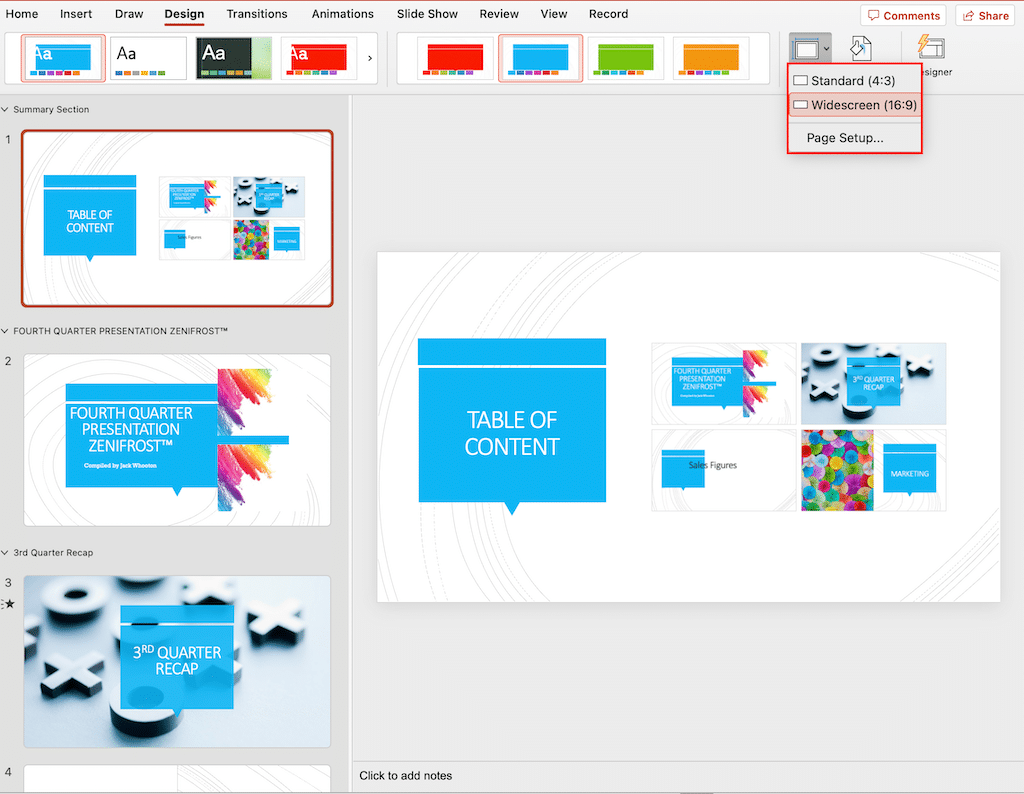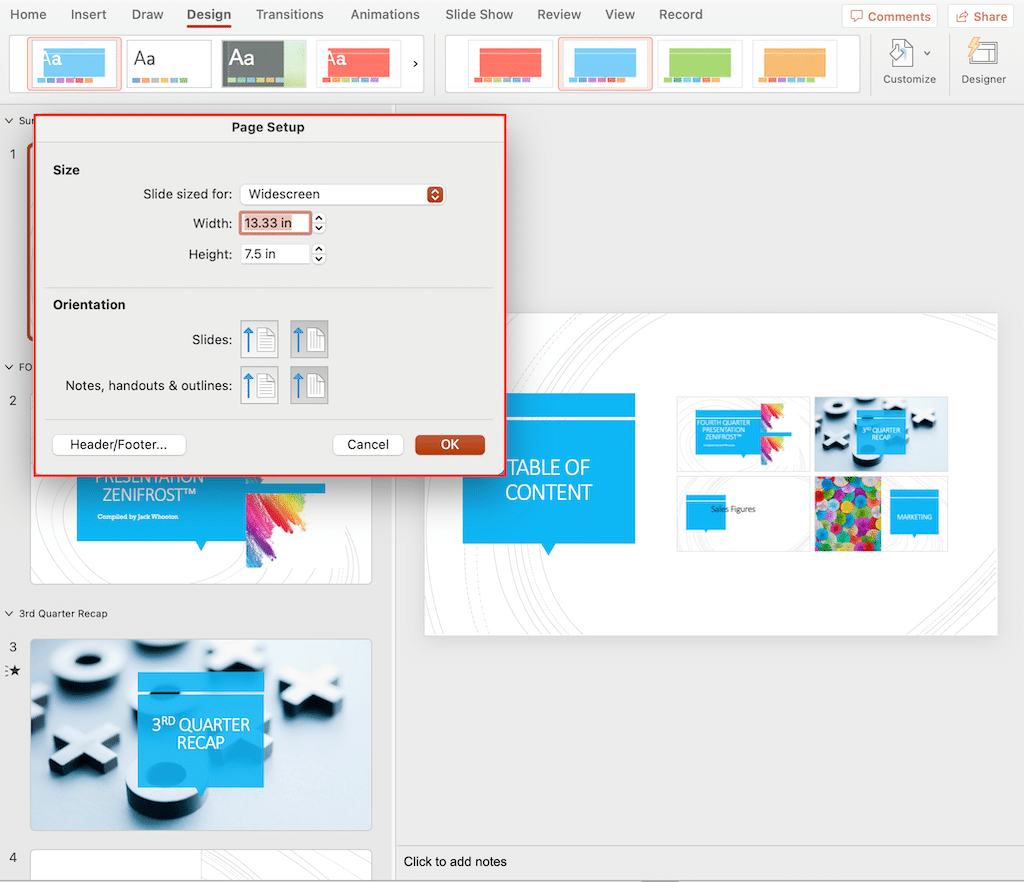Ever started making a presentation in PowerPoint, only to realize that the slides are too small, or too big?
It’s happened to the best of us.
The good news is, adjusting the slide size in PowerPoint is a simple process that can help you avoid this problem and create presentations that look just right.
To adjust the slide size in PowerPoint, click on the “Design” tab, and then “Slide Size.” You can choose from two standard slide sizes, either “Standard (4:3)” or “Widescreen (16:9).” Additionally, you can also choose a custom slide size by entering the dimensions manually.
In this article, we’ll take you through the steps of adjusting the slide size in your presentation.
You’ll also learn about the various options available for slide size, and why it’s important to choose the right one for your presentation.
Let’s get started!

What is Slide Size in PowerPoint?
Slide size in PowerPoint refers to the dimensions of a single slide in a presentation. It determines the width and height of the slide and can be customized to fit different screen aspect ratios and output formats.

Aspect Ratio: This is the proportional relationship between the width and height of a slide. The two most common aspect ratios for slides are 4:3 (standard) and 16:9 (widescreen).
Remember, the aspect ratio you choose will depend on the intended display or output format of your presentation.
Output Format: The slide size can be adjusted based on the output format you plan to use. For example, if you’re creating a presentation for a standard projector, you might choose a 4:3 aspect ratio.
On the other hand, if your presentation will be displayed on a widescreen TV or uploaded to an online platform, a 16:9 aspect ratio is typically recommended.
By customizing the slide size, you can ensure that your actual presentation looks its best on various devices and platforms.

2 Ways How to Adjust the Slide Size in PowerPoint
There are two ways to adjust the slide size in your presentation: using the default settings or customizing the size to meet your specific needs.
1. How to Adjust Slide Size Using the Default Settings
If you are using PowerPoint 2013 or later, you can adjust the slide size using the default settings.
Here’s how to do it:
Open your PowerPoint presentation.
Click on the “Design” tab in the Ribbon menu.
In the “Customize” group, click “Slide Size.”

Choose either “Standard (4:3)” or “Widescreen (16:9)” from the drop-down menu.
PowerPoint will adjust the slide size according to your selection.

Note: In PowerPoint 2010 and earlier versions, the “Design” tab is called the “Page Layout” tab. The steps are the same.
Now that you’ve learned how to adjust the slide size using the default settings, let’s move on to customizing the size to fit your specific needs.
2. How to Adjust Slide Size by Customizing It
If you have specific slide dimensions in mind for your presentation slides, you can easily customize the slide size in your presentation.
Follow these steps:
Open your presentation.
Click on the “Design” tab in the Ribbon menu.
In the “Customize” group, click “Slide Size” and then select “Custom Slide Size” or “Page Setup”.

In the “Slide Size” dialog box, you can choose from a list of pre-defined slide sizes, including “On-screen Show,” “Letter Paper,” “A4 Paper,” and more. Alternatively, you can enter custom width and height values in the “Width” and “Height” boxes.
Click “OK” to apply your custom size.

Now that you’ve learned how to adjust the slide size in your presentation, let’s take a look at the different options available for slide size.
Options for Slide Size in PowerPoint
When you’re creating a presentation in PowerPoint, you have a few different options for the slide size. You can choose between the standard size (4:3) and the widescreen size (16:9).
Let’s take a closer look at these options and when you might want to use each one.

1. Standard Size (4:3)
The standard size in PowerPoint is a 4:3 aspect ratio. This means that for every 4 units of width, there are 3 units of height. It’s the traditional size for older television screens and projectors.
The 4:3 aspect ratio provides a more square-shaped slide orientation, which can be beneficial for certain types of content, such as:
Printed handouts
Vertical designs
Content intended for older display systems
Certain templates and design layouts

2. Widescreen Size (16:9)
The widescreen slide size in PowerPoint is a 16:9 aspect ratio. This means that for every 16 units of width, there are 9 units of height. It’s the standard size for most modern high-definition displays, including computer monitors, TVs, and projectors.
The 16:9 aspect ratio provides a more rectangular-shaped slide orientation, which can be beneficial for certain types of content, such as:
Video content
Web-based presentations
Screen sharing
Detailed images
Presentations that need to be compatible with a wide range of devices
Now that you’ve learned about the two main options for slide size for your presentation, let’s discuss why it’s important to choose the right one for your presentation.

Why Choose the Right Slide Size in PowerPoint?
Choosing the right slide size is crucial for creating an effective and professional-looking presentation. The size of your slides not only affects the layout and design but also influences how your content is displayed on different screens and devices.

Here are some key reasons why you should carefully consider your slide sizes:
Optimized content layout: The size of your slides will determine how much content can be displayed at once. A larger slide size, such as widescreen (16:9), allows for more space to work with, enabling you to create visually appealing and uncluttered layouts.
Consistency across devices: By selecting one slide size, you can ensure that your presentation will look consistent and well-proportioned when viewed on various devices, including laptops, projectors, and large displays.

Enhanced readability: Larger slides provide more room for text and images, making it easier for your audience to read and understand your content, even from a distance.
Professional appearance: A carefully chosen slide size demonstrates attention to detail and a commitment to delivering a high-quality presentation. It can also help you stand out as a professional and competent presenter.
Now that you understand the importance of choosing the right slide size for your presentation, let’s review the steps you can take to adjust it in your own PowerPoint presentations.

Final Thoughts
Learning how to adjust the slide size in PowerPoint can significantly enhance the quality of your presentations. By understanding the various options available and making the right choice, you can ensure that your content is well-organized, visually appealing, and consistent across different devices and screens.
So, whether you need a standard 4:3 aspect ratio or a widescreen 16:9 format, PowerPoint makes it easy to customize the slide size to meet your specific needs.
Furthermore, this flexibility allows you to create professional and polished presentations that leave a lasting impression on your audience.

So, the next time you start working on a presentation, remember the importance of slide size and use the knowledge you’ve gained here to make the right choice. Happy presenting!
If you want to learn more about using Powerpoint to enhance the visuals of your data analysis, check out our video below:
Frequently Asked Questions
How can I change the slide size in my PowerPoint presentation to A4?
To change the slide size to A4, follow these steps:
Click on the “Design” tab in the Ribbon menu.
In the “Customize” group, click “Slide Size” and then “Custom Slide Size.”
In the “Slide Size” dialog box, select “A4 Paper” from the “Slides sized for” dropdown menu.
Click “OK” to apply the A4 slide size.
What is the standard slide size in PowerPoint?
The standard slide size in your presentation is 10 inches by 7.5 inches, which is a 4:3 aspect ratio. However, with newer versions of PowerPoint, the default slide size is 13.333 inches by 7.5 inches, also a 4:3 aspect ratio.
How do I set custom dimensions for my PowerPoint slides?
To set custom slide dimensions for your PowerPoint slides, follow these steps:
Click on the “Design” tab in the Ribbon menu.
In the “Customize” group, click “Slide Size” and then “Custom Slide Size.”
In the “Slide Size” dialog box, enter your desired width and height in the “Width” and “Height” boxes.
Click “OK” to apply the custom slide size.
Repeat steps 1-4 for all the slides or selected slides only. You can then proceed to number slides or otherwise improve your slides.
What is the widescreen size in PowerPoint?
The widescreen size in PowerPoint is a 16:9 aspect ratio. This translates to a slide size of 13.333 inches by 7.5 inches in PowerPoint 2013 and later versions, and 10 inches by 5.625 inches in PowerPoint 2010 and earlier versions.
How do I change the slide size in PowerPoint to 16:9?
To change the slide size in your presentation to 16:9, follow these steps:
Click on the “Design” tab in the Ribbon menu.
In the “Customize” group, click “Slide Size” and then “Widescreen (16:9).”
How do I adjust the aspect ratio of PowerPoint slides?
To adjust the aspect ratio of PowerPoint slides, follow these steps:
Click on the “Design” tab in the Ribbon menu.
In the “Customize” group, click “Slide Size” and then “Custom Slide Size.”
In the “Slide Size” dialog box, select your desired aspect ratio from the “Slides sized for” dropdown menu.
Click “OK” to apply the new aspect ratio.















